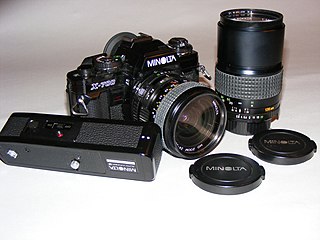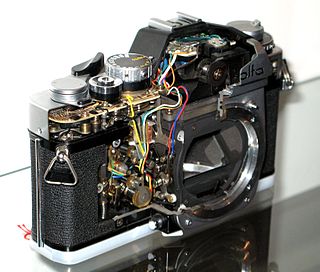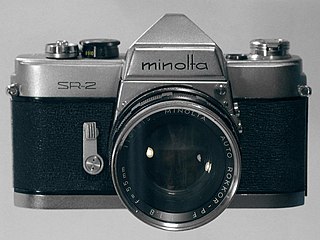Nomenclature
Elements Groups [lower-alpha 1] | 3 | 4 | 5 | 6 | 7 | 8 | 9 | 10 | 11 | 12 | ||
|---|---|---|---|---|---|---|---|---|---|---|---|---|
| C | D | E | F | G | H | I | J | K | L | |||
| 3 | (trēs) | T | -TC (100, 135) | -TD (45, 300) | not used | |||||||
| 4 | (quattuor) | Q | — | -QD (135, 300) | -QE (35, 100, 200) | -QF (50, 200, 250) | not used | -QH (21) | not used | |||
| 5 | (penta) | P | — | -PE (200) | -PF (50, 53, 55, 58, 85, 100, 135) | -PG (18, 50, 58, 135) | not used | -PI (21) | not used | |||
| 6 | (hexa) | H | — | -HF (300) | -HG (35) | -HH (35) | not used | |||||
| 7 | (septem) | S | — | -SG (28) | not used | -SI (28) | not used | |||||
| 8 | (octō) | O | — | not used | -OK (16) | not used | ||||||
| 9 | (novem) | N | — | not used | -NL (21) | |||||||
Most Minolta lenses for SR-mount cameras are branded Rokkor ; in the United States, to combat unofficial gray market imports, lenses officially imported were engraved as Rokkor-X, with the X colored orange. Before 1975, lenses also carried a two-letter suffix indicating the construction. [1]
Because the number of groups is always equal to or less than the number of lens elements, certain combinations are not possible (for instance -QC, which would be a four-group, three-element lens). In other cases, the combination is not used, such as -QG, which would be a four-group, seven-element lens. Although the -OJ suffix was never used for a production lens, a prototype MC Rokkor-OJ 24 mm f/2.8 lens was shown at Photokina 1970. [2]
In addition to Rokkor-branded lenses, Minolta also sold a lower-cost line of lenses, designated Celtic. [3] : 66 Compared to the Rokkor lenses, Celtic lenses have less sophisticated coatings. [4] : 8
In the final series of lenses (after 1981), the "Rokkor" branding was dropped.
Generations
- MC and MD tabs on Minolta XD-5
- MC tab, just under the engraved f/16 on the aperture ring of the lens, engages with a corresponding tab (colored black) on the camera body.
- As the lens is stopped down, the in-camera meter is able to determine the aperture that was set (in this case, f/8) by the displacement of the black metering tab.
- The MD tab displaces a separate tab on the camera body (colored silver, in the bottom right corner of this photograph) when the lens is set to its minimum diaphragm (f/22) for shutter-priority autoexposure.
Minolta SR-mount lenses can be broken into three broad generations with some overlap: [5]
- Pre-MC (1958): Lenses with manual, preset, and automatic diaphragms, without the meter coupling (MC) tab on the aperture ring to signal the f-stop that was selected to the in-body light meter.
- MC (1966): Lenses with automatic diaphragms, with the MC tab.
- MD (1977): Lenses with automatic diaphragms and the MC tab, and an additional minimum diaphragm (MD) tab to signal the minimum aperture opening size (largest f-stop value) of the lens to the body for shutter-priority autoexposure.
In general, MD lenses tend to incorporate more plastic components and are lighter than MC and pre-MC lenses. Within each of these generations, there are minor differences which are generally cosmetic changes.
| Name | Generation | Years | Example | Notes |
|---|---|---|---|---|
| Pre-MC | SR | 1958 – 1966 |  | The earliest lenses had pre-set and manual aperture controls. Lens engraving included "Rokkor" branding, basic construction details, maximum aperture (1:nnn), and focal length (f=nn mm). |
| AR (I) | 1958 – 1960 | These were contemporaneous with the SR lenses, and had automatic diaphragm, as designated by the engraved "Auto Rokkor" (AR) name. | ||
| AR (II) | 1961 – 1964 |  | These are distinguished from the earlier AR (I) lenses by the evenly spaced f-stop engravings. | |
| "Compact" | 1965 – 1967 | Encompassing both AR and SR types; most have 52 mm front filter threads using a black-colored nose, while preceding generations had 55 mm with a chrome nose. | ||
| MC | MC (I) | 1966 – 1969 |  | These lenses have a meter coupling tab on the aperture ring to signal the aperture setting to the body. The aperture ring is colored silver, while prior generations were colored black. |
| MC (II) | 1967 – 1972 |  | Cosmetically similar to MC (I) with a more deeply scalloped focusing grip knurling. | |
| MC-X | 1972 – 1976 |  | Rubberized focusing grip with square, truncated pyramid shapes; aperture ring reverts to black. Starting in the mid-1970s, Minolta began adding two to three anti-reflection coating layers [7] to balance color and contrast across the lens lineup. [8] | |
| MC Celtic | 1972 – 1976 | Budget line. Cosmetically similar to MC-X, with a different rubber grip waffle pattern (finely-spaced rectangular) and simplified coatings. The first lens was a 135 mm f/3.5 branded MC Celtic-QD, with a metal focusing ring and silver aperture ring similar to MC (I), and the Minolta name did not appear on the lens. [9] [10] | ||
| MD | MD (I) | 1977 |  | Additional tab added to signal the minimum aperture value (largest f-stop number, smallest diaphragm opening) has been set; aperture ring becomes plastic. |
| MD (II) | 1978 – 1980 |  | Cosmetic update to put focal length before maximum aperture on the front nameplate. | |
| MD Celtic | 1977 – 1980 | Update of MC Celtic, adding MD tab. | ||
| MD (III) | 1981 – 1984 |  | Dropped "Rokkor" branding; sometimes referred to as "Plain MD". Mechanical lock added to aperture ring to secure the aperture ring at minimum value. | |
| MD (IIIa) | 1985 – 1996 | Possibly rebranded lenses built by a third-party manufacturer, lacking features compared to MD (III). |



















